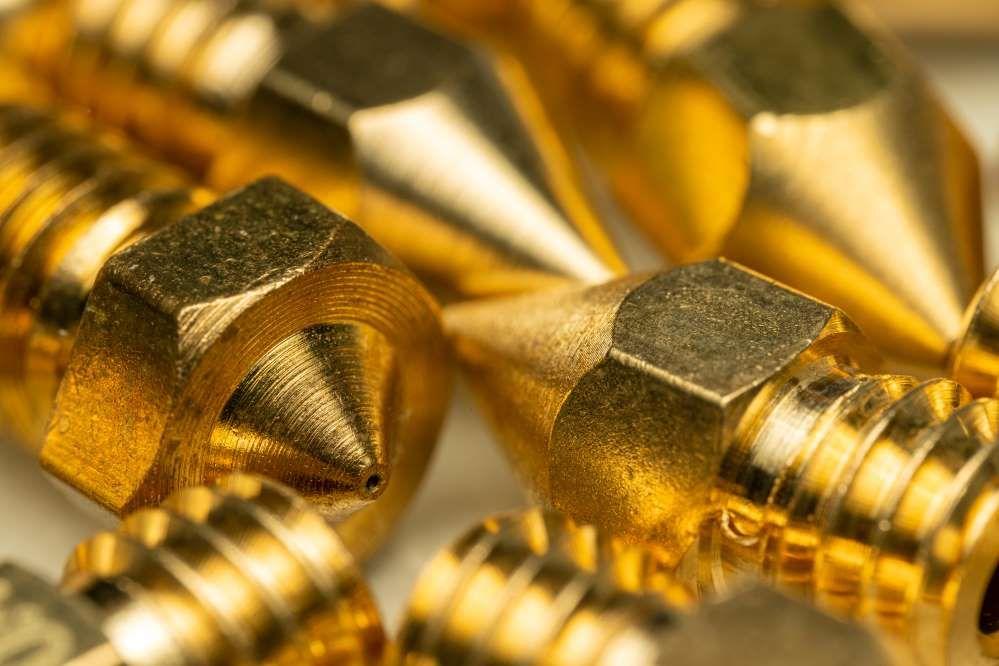
Guide to 3D Printer Nozzles – Brass, Stainless Steel, Hardened Steel, and Diamond-Tipped
Share
The nozzle is one of the most important components of a 3D printer, and its material has a great impact on print quality, durability, and material compatibility. Choosing the right nozzle can significantly extend the lifespan and improve the print result.
This guide compares the most common nozzle materials and helps you find the best choice for your application.
🟡 Brass nozzle 
Best for basic use and non-abrasive materials
Brass is the most popular nozzle material due to its excellent thermal conductivity. It heats up quickly and provides a very smooth print, making it a perfect choice for PLA, ABS, PETG and TPU filaments.
Advantages:
- Excellent thermal conductivity
- Affordable and easily available
- High-quality print result
Disadvantages:
- Wears quickly on abrasive materials (such as carbon fiber or wood fillers)
- Short service life in continuous use
⚪ Stainless steel nozzle 
Best for food and medical printing
Stainless steel is a good choice when you need clean and hygienic printing. It is more durable than brass, but has lower thermal conductivity. This nozzle is suitable for parts that come into contact with food, for example.
Advantages:
- Lead-free and safe for food use
- More durable than brass
- Does not rust easily
Disadvantages:
- Lower thermal conductivity → slower printing
- Not optimal for abrasive materials
⚫ Hardened steel nozzle 
The best all-rounder – durable, versatile and reasonably priced
Hardened steel offers the best balance between durability, thermal conductivity and price. It is suitable for almost all filament types, including abrasive ones such as carbon fiber, fiberglass and metal-filled filaments. The nozzle lasts significantly longer than brass or stainless steel and maintains its precision for a long time.
Advantages:
- Extremely wear-resistant – up to 10x longer service life than brass
- Suitable for almost all materials
- Good thermal conductivity
- Cost-effective and long-lasting solution
Disadvantages:
- Thermal conductivity slightly lower than brass, but the difference is minimal in practice
🟢 Recommendation:
If you are looking for the best all-round choice that will work in most situations and last a long time, hardened steel is the most sensible option .
💎 Diamond tip nozzle 
The ultimate solution – but the price is often not justified
Diamond-tipped nozzles are a luxury item in the 3D printing world. They are virtually wear-resistant and work flawlessly with all materials, including the most abrasive filaments such as carbon, glass, and metal fillers.
However – their price is many times higher than others , often in the hundreds of euros per nozzle . In practice, most users do not benefit from this extra durability.
Advantages:
- Extreme wear resistance
- Excellent thermal conductivity (with copper body)
- Accurate and stable print quality
Disadvantages:
- Very high price – often over 10x more expensive than hardened steel
- Superior quality for everyday use
- Doesn't offer significant benefit for most printers
Summary
| Nozzle material | Resistance | Thermal conductivity | Suitable for abrasive materials | Price | Best use |
|---|---|---|---|---|---|
| Brass | ★★☆☆☆ | ★★★★★ | ✖ | € | Basic filaments |
| Stainless steel | ★★★☆☆ | ★★★☆☆ | ⚠ Partially | €€ | Food use |
| Hardened steel | ★★★★★ | ★★★★☆ | ✔✔✔ | €€ | For multiple use |
| Diamond tip | ★★★★★★★★ | ★★★★★ | ✔✔✔✔✔ | €€€€€ | Professional use / special use |
In summary:
If you want one nozzle that lasts, works, and is worth the price , choose hardened steel .
The diamond-tipped nozzle is impressive, but for most users, its price is clearly excessive in relation to the benefit.
